Abstract
The aim of the study was to verify whether antibiotics excreted by the normal pancreas are also excreted in human necrotizing pancreatitis, reaching the tissue sites of the infection. Twelve patients suffering from acute necrotizing pancreatitis were treated with imipenem-cilastatin (0.5 g), mezlocillin (2 g), gentamicin (0.08 g), amikacin (0.5 g), pefloxacin (0.4 g), and metronidazole (0.5 g). Serum and necrotic samples were collected simultaneously at different time intervals after parenteral drug administration by computed tomography-guided needle aspiration, intraoperatively, and from surgical drainages placed during surgery. Drug concentrations were determined by microbiological and high-performance liquid chromatography assays. All antibiotics reached the necrotic tissues, but with varying degrees of penetration, this being low for aminoglycosides (13%) and high in the case of pefloxacin (89%) and metronidazole (99%). The concentrations of pefloxacin (13.0 to 23 micrograms/g) and metronidazole (8.4 micrograms/g) in the necrotic samples were distinctly higher than the MICs for the organisms most commonly isolated in this disease; the concentrations in tissue of imipenem (3.35 micrograms/g) and mezlocillin (8.0 and 15.0 micrograms/g) did not always exceed the MICs for 90% of strains tested, whereas the aminoglycoside concentrations in necrotic tissue (0.5 microgram/g) were inadequate. Repeated administration of drugs (for 3, 7, 17, and 20 days) seems to enhance penetration of pefloxacin, imipenem, and metronidazole into necrotic pancreatic tissue. The choice of antibiotics in preventing infected necrosis during necrotizing pancreatitis should be based on their antimicrobial activity, penetration rate, persistence, and therapeutic concentrations in the necrotic pancreatic area. These requisites are provided by pefloxacin and metronidazole and to a variable extent by imipenem and mezlocillin.
Full text
PDF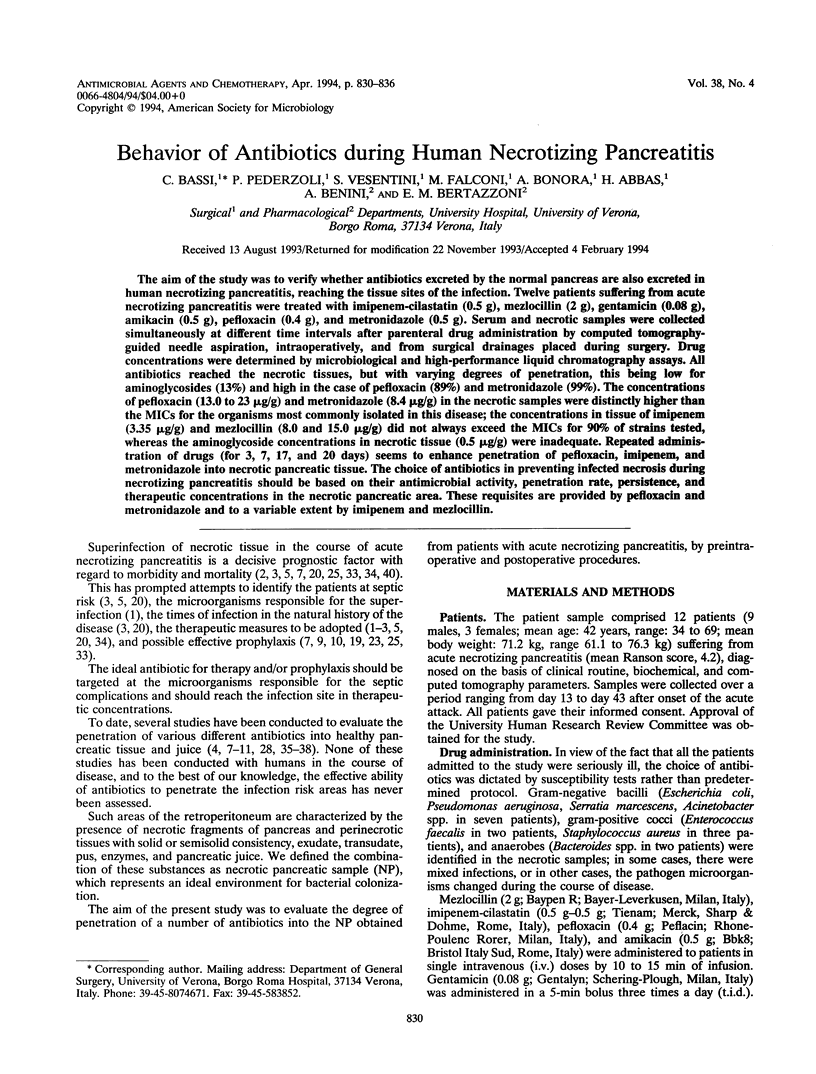
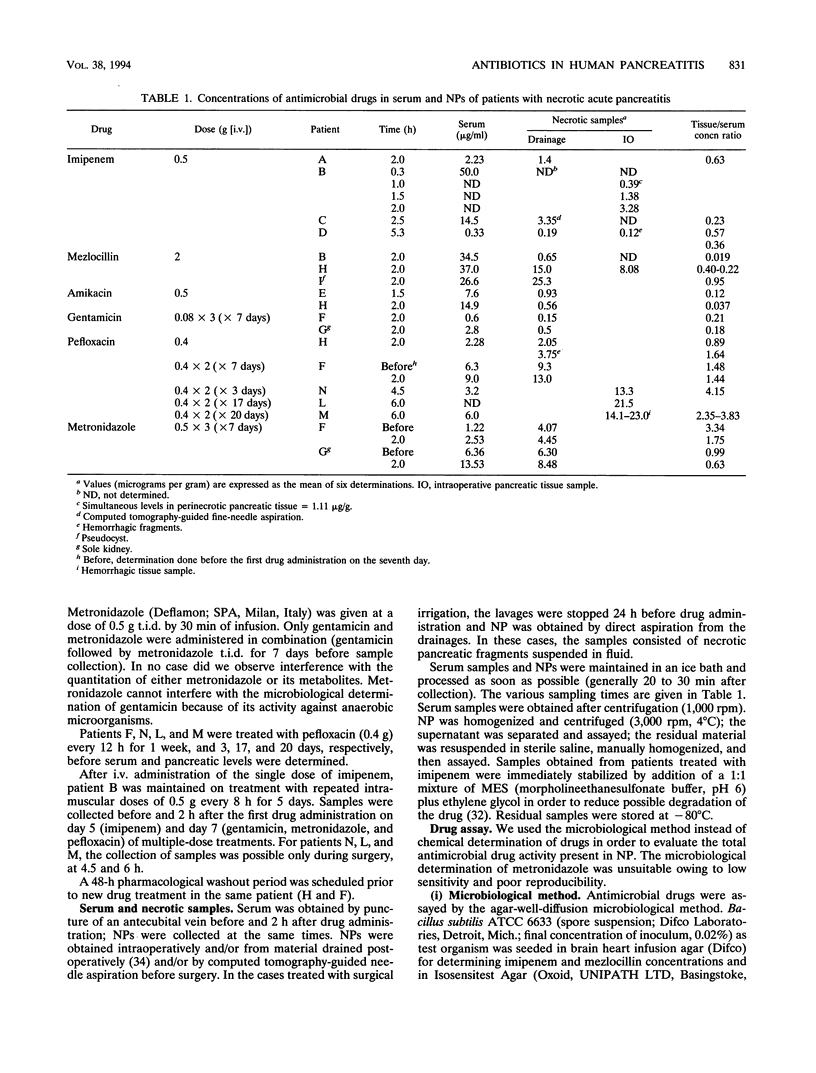
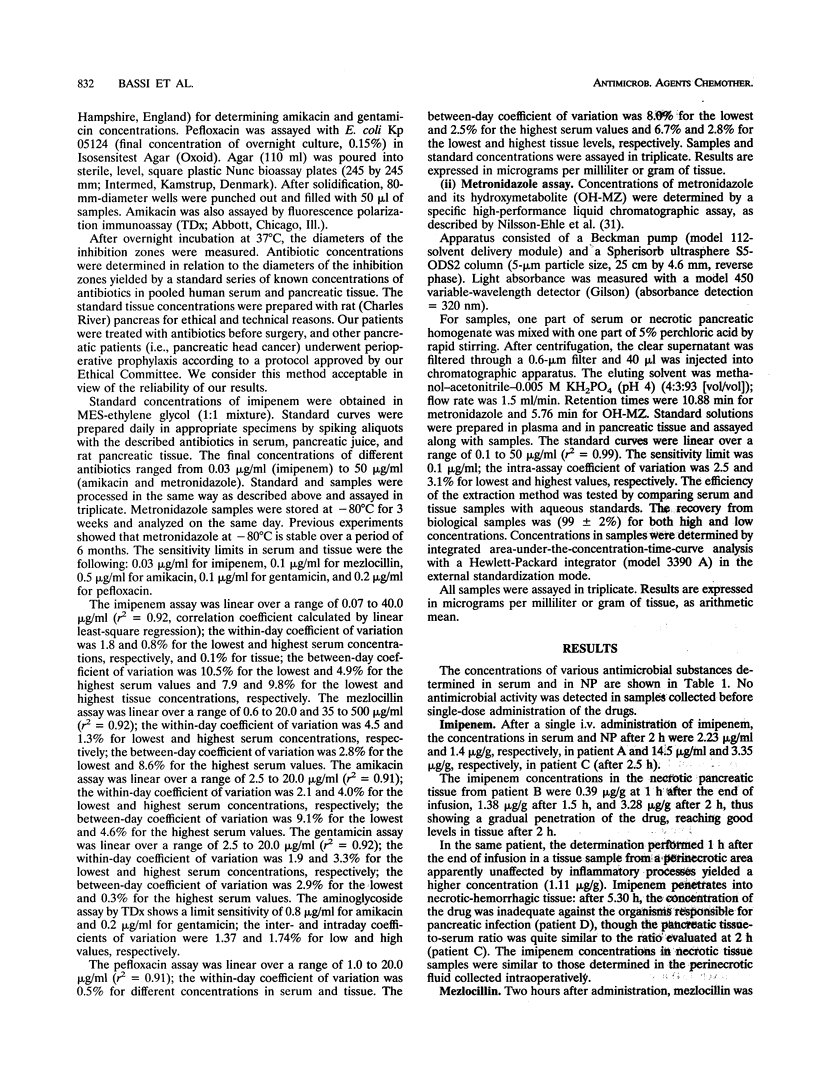
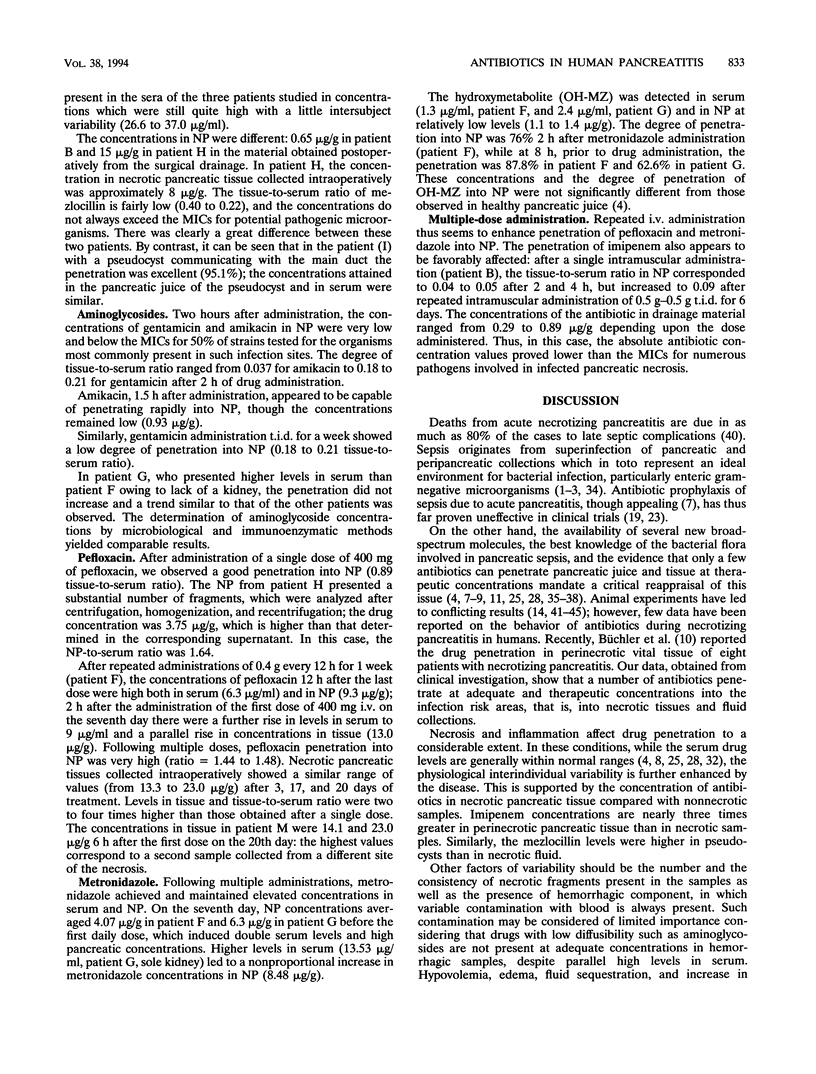
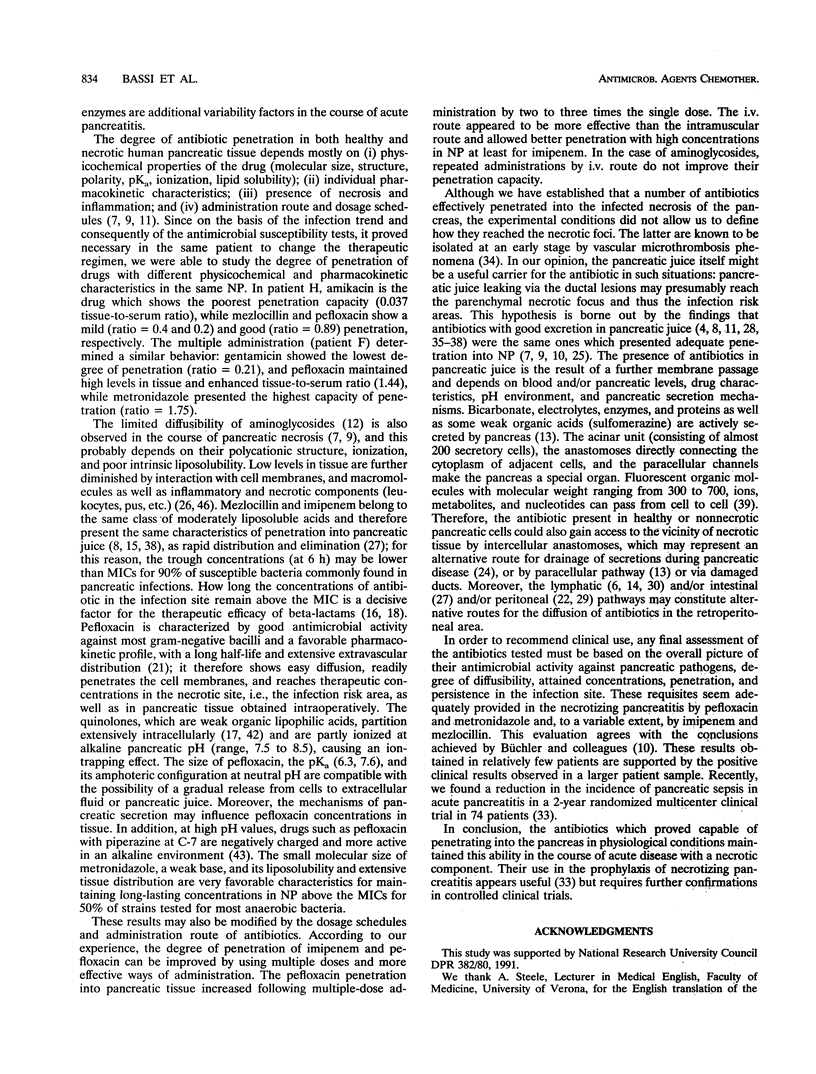
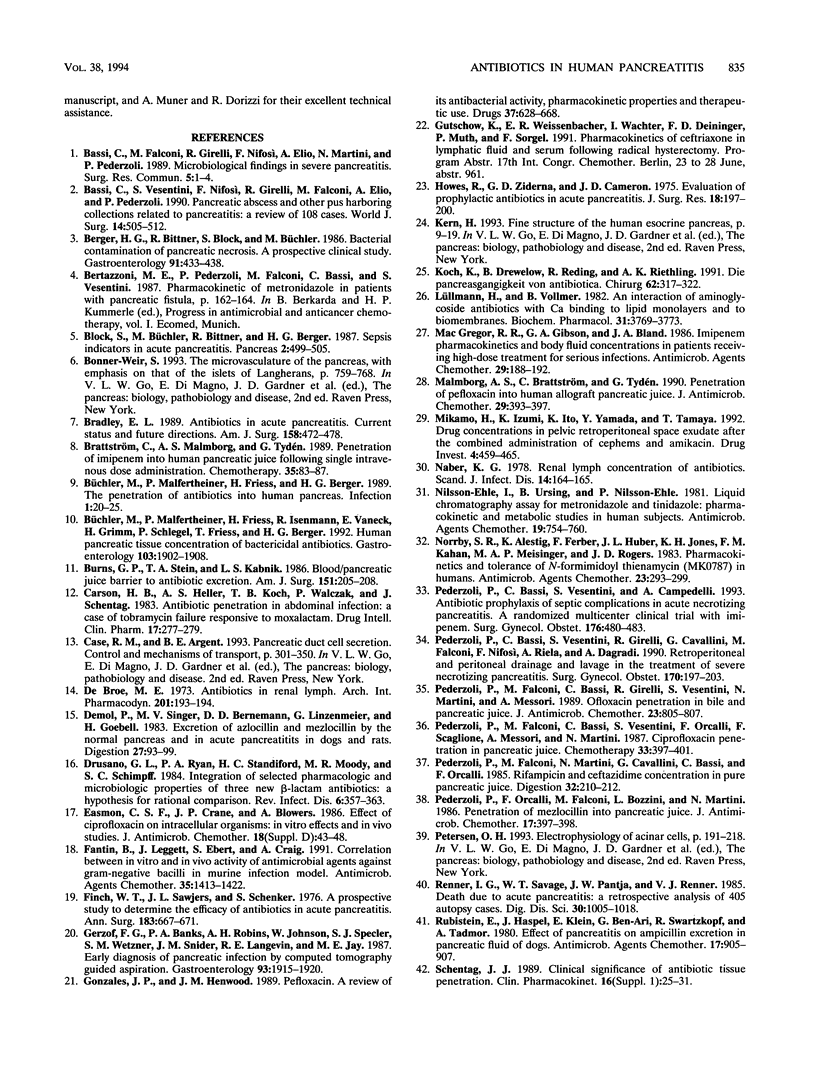
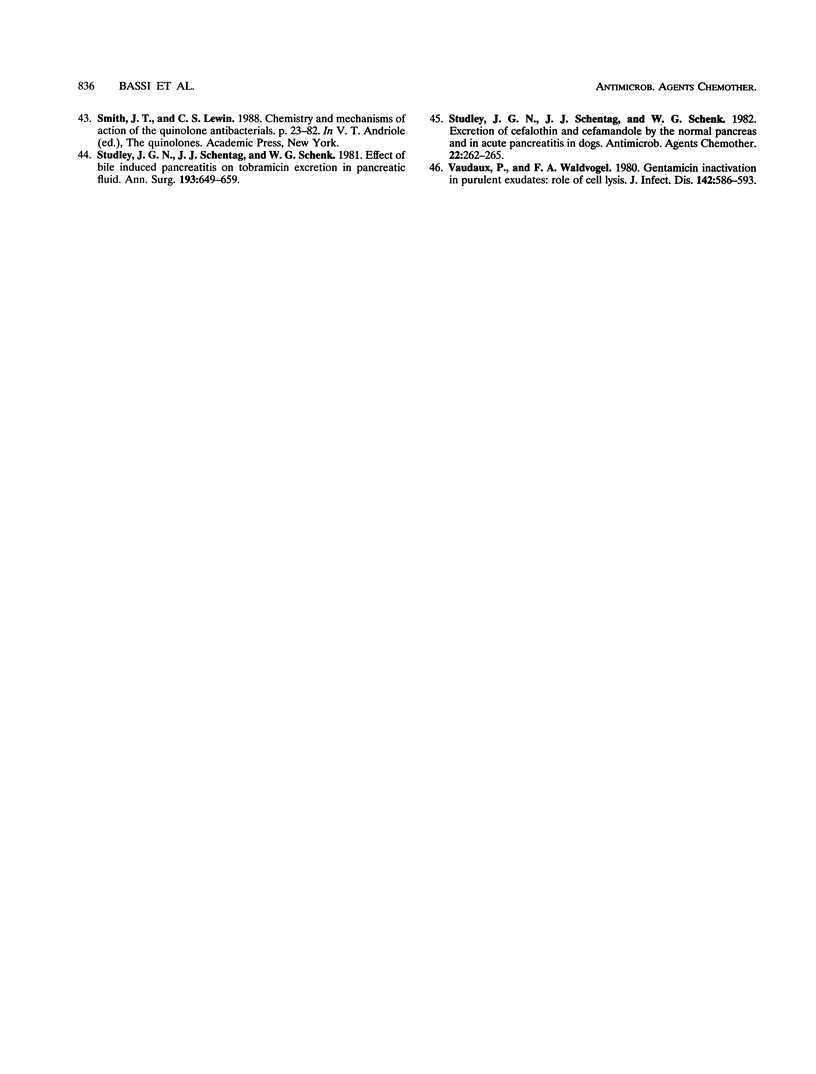
Selected References
These references are in PubMed. This may not be the complete list of references from this article.
- Bassi C., Vesentini S., Nifosì F., Girelli R., Falconi M., Elio A., Pederzoli P. Pancreatic abscess and other pus-harboring collections related to pancreatitis: a review of 108 cases. World J Surg. 1990 Jul-Aug;14(4):505–512. doi: 10.1007/BF01658676. [DOI] [PubMed] [Google Scholar]
- Beger H. G., Bittner R., Block S., Büchler M. Bacterial contamination of pancreatic necrosis. A prospective clinical study. Gastroenterology. 1986 Aug;91(2):433–438. doi: 10.1016/0016-5085(86)90579-2. [DOI] [PubMed] [Google Scholar]
- Block S., Büchler M., Bittner R., Beger H. G. Sepsis indicators in acute pancreatitis. Pancreas. 1987;2(5):499–505. doi: 10.1097/00006676-198709000-00002. [DOI] [PubMed] [Google Scholar]
- Bradley E. L., 3rd Antibiotics in acute pancreatitis. Current status and future directions. Am J Surg. 1989 Nov;158(5):472–478. doi: 10.1016/0002-9610(89)90290-0. [DOI] [PubMed] [Google Scholar]
- Brattström C., Malmborg A. S., Tydén G. Penetration of imipenem into human pancreatic juice following single intravenous dose administration. Chemotherapy. 1989;35(2):83–87. doi: 10.1159/000238652. [DOI] [PubMed] [Google Scholar]
- Burns G. P., Stein T. A., Kabnick L. S. Blood-pancreatic juice barrier to antibiotic excretion. Am J Surg. 1986 Feb;151(2):205–208. doi: 10.1016/0002-9610(86)90070-x. [DOI] [PubMed] [Google Scholar]
- Büchler M., Malfertheiner P., Friess H., Bittner R., Vanek E., Schlegel P., Beger H. G. The penetration of antibiotics into human pancreas. Infection. 1989 Jan-Feb;17(1):20–25. doi: 10.1007/BF01643494. [DOI] [PubMed] [Google Scholar]
- Büchler M., Malfertheiner P., Friess H., Isenmann R., Vanek E., Grimm H., Schlegel P., Friess T., Beger H. G. Human pancreatic tissue concentration of bactericidal antibiotics. Gastroenterology. 1992 Dec;103(6):1902–1908. doi: 10.1016/0016-5085(92)91450-i. [DOI] [PubMed] [Google Scholar]
- Carson H. B., Heller A. S., Koch T. B., Walczak P., Schentag J. J. Antibiotic penetration in abdominal infection: a case of tobramycin failure responsive to moxalactam. Drug Intell Clin Pharm. 1983 Apr;17(4):277–279. doi: 10.1177/106002808301700407. [DOI] [PubMed] [Google Scholar]
- De Broe M. E. Antibiotics in renal lymph. Arch Int Pharmacodyn Ther. 1973 Jan;201(1):193–194. [PubMed] [Google Scholar]
- Demol P., Singer M. V., Bernemann D., Linzenmeier G., Goebell H. Excretion of azlocillin and mezlocillin by the normal pancreas and in acute pancreatitis in dogs and rats. Digestion. 1983;27(2):93–99. doi: 10.1159/000198936. [DOI] [PubMed] [Google Scholar]
- Drusano G. L., Ryan P. A., Standiford H. C., Moody M. R., Schimpff S. C. Integration of selected pharmacologic and microbiologic properties of three new beta-lactam antibiotics: a hypothesis for rational comparison. Rev Infect Dis. 1984 May-Jun;6(3):357–363. doi: 10.1093/clinids/6.3.357. [DOI] [PubMed] [Google Scholar]
- Easmon C. S., Crane J. P., Blowers A. Effect of ciprofloxacin on intracellular organisms: in-vitro and in-vivo studies. J Antimicrob Chemother. 1986 Nov;18 (Suppl 500):43–48. doi: 10.1093/jac/18.supplement_d.43. [DOI] [PubMed] [Google Scholar]
- Fantin B., Leggett J., Ebert S., Craig W. A. Correlation between in vitro and in vivo activity of antimicrobial agents against gram-negative bacilli in a murine infection model. Antimicrob Agents Chemother. 1991 Jul;35(7):1413–1422. doi: 10.1128/aac.35.7.1413. [DOI] [PMC free article] [PubMed] [Google Scholar]
- Finch W. T., Sawyers J. L., Schenker S. A prospective study to determine the efficacy of antibiotics in acute pancreatitis. Ann Surg. 1976 Jun;183(6):667–671. doi: 10.1097/00000658-197606000-00008. [DOI] [PMC free article] [PubMed] [Google Scholar]
- Gonzalez J. P., Henwood J. M. Pefloxacin. A review of its antibacterial activity, pharmacokinetic properties and therapeutic use. Drugs. 1989 May;37(5):628–668. doi: 10.2165/00003495-198937050-00003. [DOI] [PubMed] [Google Scholar]
- Howes R., Zuidema G. D., Cameron J. L. Evaluation of prophylactic antibiotics in acute pancreatitis. J Surg Res. 1975 Feb;18(2):197–200. doi: 10.1016/0022-4804(75)90016-5. [DOI] [PubMed] [Google Scholar]
- Koch K., Drewelow B., Liebe S., Reding R., Riethling A. K. Die Pankreasgängigkeit von Antibiotica. Chirurg. 1991 Apr;62(4):317–322. [PubMed] [Google Scholar]
- Lüllmann H., Vollmer B. An interaction of aminoglycoside antibiotics with Ca binding to lipid monolayers and to biomembranes. Biochem Pharmacol. 1982 Dec 1;31(23):3769–3773. doi: 10.1016/0006-2952(82)90291-x. [DOI] [PubMed] [Google Scholar]
- MacGregor R. R., Gibson G. A., Bland J. A. Imipenem pharmacokinetics and body fluid concentrations in patients receiving high-dose treatment for serious infections. Antimicrob Agents Chemother. 1986 Feb;29(2):188–192. doi: 10.1128/aac.29.2.188. [DOI] [PMC free article] [PubMed] [Google Scholar]
- Malmborg A. S., Brattström C., Tydén G. Penetration of pefloxacin into human allograft pancreatic juice. J Antimicrob Chemother. 1990 Mar;25(3):393–397. doi: 10.1093/jac/25.3.393. [DOI] [PubMed] [Google Scholar]
- Naber K. G. Renal lymph concentrations of antibiotics. Scand J Infect Dis Suppl. 1978;(14):164–165. [PubMed] [Google Scholar]
- Nilsson-Ehle I., Ursing B., Nilsson-Ehle P. Liquid chromatographic assay for metronidazole and tinidazole: pharmacokinetic and metabolic studies in human subjects. Antimicrob Agents Chemother. 1981 May;19(5):754–760. doi: 10.1128/aac.19.5.754. [DOI] [PMC free article] [PubMed] [Google Scholar]
- Norrby S. R., Alestig K., Ferber F., Huber J. L., Jones K. H., Kahan F. M., Meisinger M. A., Rogers J. D. Pharmacokinetics and tolerance of N-formimidoyl thienamycin (MK0787) in humans. Antimicrob Agents Chemother. 1983 Feb;23(2):293–299. doi: 10.1128/aac.23.2.293. [DOI] [PMC free article] [PubMed] [Google Scholar]
- Pederzoli P., Bassi C., Vesentini S., Campedelli A. A randomized multicenter clinical trial of antibiotic prophylaxis of septic complications in acute necrotizing pancreatitis with imipenem. Surg Gynecol Obstet. 1993 May;176(5):480–483. [PubMed] [Google Scholar]
- Pederzoli P., Bassi C., Vesentini S., Girelli R., Cavallini G., Falconi M., Nifosi F., Riela A., Dagradi A. Retroperitoneal and peritoneal drainage and lavage in the treatment of severe necrotizing pancreatitis. Surg Gynecol Obstet. 1990 Mar;170(3):197–203. [PubMed] [Google Scholar]
- Pederzoli P., Falconi M., Bassi C., Girelli R., Vesentini S., Martini N., Messori A. Ofloxacin penetration into bile and pancreatic juice. J Antimicrob Chemother. 1989 May;23(5):805–807. doi: 10.1093/jac/23.5.805. [DOI] [PubMed] [Google Scholar]
- Pederzoli P., Falconi M., Bassi C., Vesentini S., Orcalli F., Scaglione F., Solbiati M., Messori A., Martini N. Ciprofloxacin penetration in pancreatic juice. Chemotherapy. 1987;33(6):397–401. doi: 10.1159/000238527. [DOI] [PubMed] [Google Scholar]
- Pederzoli P., Orcalli F., Falconi M., Bozzini L., Martini N. Penetration of mezlocillin into pancreatic juice. J Antimicrob Chemother. 1986 Mar;17(3):397–397. doi: 10.1093/jac/17.3.397. [DOI] [PubMed] [Google Scholar]
- Renner I. G., Savage W. T., 3rd, Pantoja J. L., Renner V. J. Death due to acute pancreatitis. A retrospective analysis of 405 autopsy cases. Dig Dis Sci. 1985 Oct;30(10):1005–1018. doi: 10.1007/BF01308298. [DOI] [PubMed] [Google Scholar]
- Rubinstein E., Haspel J., Klein E., Ben-Ari G., Schwarzkopf R., Tadmor A. Effect of pancreatitis on ampicillin excretion in pancreatic fluids of dogs. Antimicrob Agents Chemother. 1980 Jun;17(6):905–907. doi: 10.1128/aac.17.6.905. [DOI] [PMC free article] [PubMed] [Google Scholar]
- Schentag J. J. Clinical significance of antibiotic tissue penetration. Clin Pharmacokinet. 1989;16 (Suppl 1):25–31. doi: 10.2165/00003088-198900161-00005. [DOI] [PubMed] [Google Scholar]
- Studley J. G., Schentag J. J., Schenk W. G., Jr Effect of bile induced pancreatitis on tobramycin excretion in pancreatic fluid. Ann Surg. 1981 May;193(5):649–654. doi: 10.1097/00000658-198105000-00016. [DOI] [PMC free article] [PubMed] [Google Scholar]
- Studley J. G., Schentag J. J., Schenk W. G., Jr Excretion of cephalothin and cefamandole by the normal pancreas and in acute pancreatitis in dogs. Antimicrob Agents Chemother. 1982 Aug;22(2):262–265. doi: 10.1128/aac.22.2.262. [DOI] [PMC free article] [PubMed] [Google Scholar]
- Vaudaux P., Waldvogel F. A. Gentamicin inactivation in purulent exudates: role of cell lysis. J Infect Dis. 1980 Oct;142(4):586–593. doi: 10.1093/infdis/142.4.586. [DOI] [PubMed] [Google Scholar]


